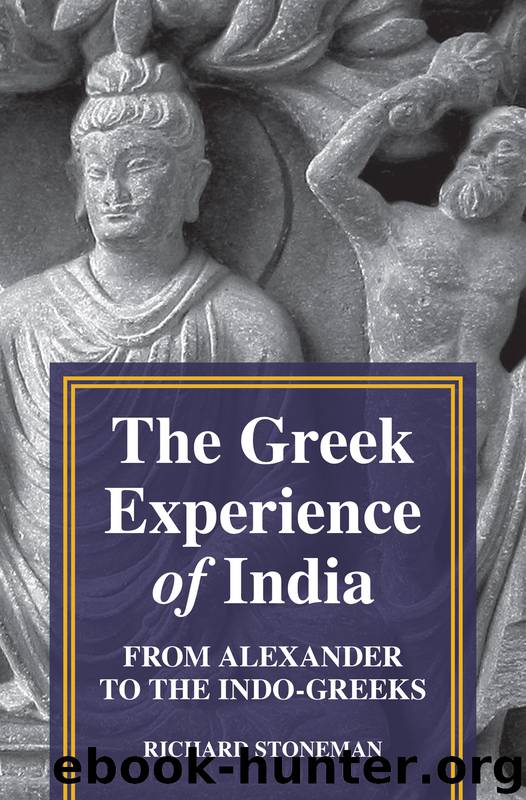The Greek Experience of India by Richard Stoneman

Author:Richard Stoneman
Language: eng
Format: epub
Publisher: Princeton University Press
Published: 2018-12-02T00:00:00+00:00
Other Beasts
As you wake from one India into another,
The dream-animals shimmer and swim into new shapes.
Yet they are real. God made them. They must mean something.
— MATTHEW FRANCIS, MANDEVILLE (2008), 35
Megasthenes has much less to say about other beasts of India. Strabo speaks of the size and ferocity of tigers.38 (Nearchus had only seen their skins,39 as he had also seen those of the gold-digging ants, which resembled those of leopards: see below.) He describes the monkeys whose faces are black and tails a yard (1 m) long, as large as large dogs: that is, the black-faced langurs common further south and east in India,40 while the north-west (and, in modern times, the region of Delhi and Agra) is characterised by the smaller, less aggressive pink-faced rhesus macaque. He does not go into the catching of monkeys, which Cleitarchus dilated upon.41 He writes of flying serpents with wings like bats (just possibly flying foxes: our driver in Delhi pointed out these ‘bat-birds’, as he called them, roosting in the arjun trees in Janpath),42 and huge winged scorpions, as well as large savage dogs. He also mentions enormous snakes, probably boa constrictors, though a connection has also been made with the mythical Nagas of the north-west.43
Our view of Megasthenes’ account of Indian fauna must depend on what we make of Aelian’s De natura animalium 16.2–22. Some of this is certainly from Megasthenes, but how much of it? Schwanbeck included it as a ‘doubtful’ fragment of Megasthenes, for reasons given in his commentary,44 while Jacoby excluded it. It begins with accounts of several birds. First comes the parrot, of which he distinguishes three species: Nearchus mentioned only one and Ctesias describes a parrot with a red face and a black beard, that is ‘dark blue as far as the neck … like cinnabar’, presumably the macaw.45 Then pigeons and peacocks are mentioned, and what is obviously the guinea-fowl; the mynah bird, which Ctesias calls kerkion, the unidentifiable kelas, and the hoopoe, about which Aelian tells a long and fascinating story (see below). Then come the pangolin, sea-snakes and wild horses and asses.
There follows an account of monkeys, with red faces and tips to their tails, about the size of Hyrcanian dogs. This is treated by Schwanbeck as F 13b of Megasthenes because it discusses monkeys, as does F 13a, which is also from Aelian,46 but in which Megasthenes is mentioned by name. It should be noted, however, that the latter fragment describes black-faced langurs whilst the former describes red-faced macaques. In both cases the animals are said to live in the country of the Prasii, and the red-faced monkeys are especially common in Latage, an unidentified place. Does this mean that the two fragments come from different authors, familiar with different parts of the country? Or did Megasthenes describe both kinds? If so, why has Aelian excerpted this discussion in two different places in his book?
The giant horse follows, which is hunted for its beautiful tail. What can this be? Aelian goes on to describe whales, various kinds of fish, and turtles from the sea surrounding Taprobane.
Download
This site does not store any files on its server. We only index and link to content provided by other sites. Please contact the content providers to delete copyright contents if any and email us, we'll remove relevant links or contents immediately.
| Africa | Americas |
| Arctic & Antarctica | Asia |
| Australia & Oceania | Europe |
| Middle East | Russia |
| United States | World |
| Ancient Civilizations | Military |
| Historical Study & Educational Resources |
Mythos (2019 Re-Issue) by Stephen Fry(1199)
Alexander the Great by Robin Lane Fox(1182)
Antigone Rising: The Subversive Power of the Ancient Myths by Helen Morales(949)
On Sparta (Penguin Classics) by Plutarch(929)
The Classical World: An Epic History From Homer to Hadrian by Robin Lane Fox(890)
The Last Days of Socrates by Plato & Christopher Rowe & Plato(889)
Persian Fire by Tom Holland(833)
Cicero by Anthony Everitt(785)
The Athenian Constitution (Classics) by Aristotle(773)
The Greek World(702)
Antigone Rising by Helen Morales(663)
The Eudemian Ethics (Oxford World's Classics) by Kenny Anthony(648)
The Riddle of the Labyrinth(635)
The Story of the Greeks (Yesterday's Classics) by Guerber H. A(623)
Lords of the Sea: The Epic Story of the Athenian Navy and the Birth of Democracy by John R. Hale(620)
Guide to Greece by Pausanias(611)
The End of the Bronze Age by Robert Drews;(597)
The Homeric Hymns (Penguin Classics) by Homer(579)
Astrology and Religion Among the Greeks and Romans by Cumont Franz(576)
